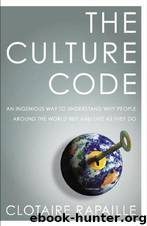The Culture Code: An Ingenious Way to Understand Why People Around the World Buy and Live as They Do by Clotaire Rapaille

Author:Clotaire Rapaille
Language: eng
Format: mobi
Tags: Ethnopsychology, Sociology, Cognition and culture, Social Science, Consumer Behavior, Workplace Culture, Cultural, General, Anthropology, American, Social perception, National characteristics, Business & Economics, Psychology
ISBN: 9780767920568
Publisher: Broadway Books
Published: 2006-06-06T06:44:46+00:00
WHAT’S COOKING? ANYTHING?
Like the need for shelter, the biological scheme for dinner is fundamental: all human beings need nourishment. But what is the continuum between the biological requirement to eat and the particular cultural scheme in America? Like the notion of home, the concept of dinner is very powerful in our culture.
Dinners have a strong ceremonial place in America. That biggest dinner of the year—Thanksgiving dinner—even commemorates the launch of our culture. We commemorate holidays and birthdays with large family dinners; the celebration dinner is one of the most common ways to mark an accomplishment, such as a promotion or a good report card.
Each of these dinners is a major event that can produce lasting memories. What imprint comes from the everyday dinner, though—the weeknight meal one shares with family (at least occasionally) after a long day of work or school? Kraft, wanting to learn how to make its products synonymous with American meals, was interested in the answer to this question, and commissioned discovery sessions to learn what dinner means in America. Later in this book, we will decode food in general, but here the focus is on the meal that, as we will see, has the most resonance in the American mind.
In the first hour of these sessions, we heard what people think about the average dinner. It was something to prepare quickly. The family rarely sat down to eat together because everyone had such a busy schedule. When they did sit down together, there was often a TV playing. The meal consisted of a takeout pizza or a pre-prepared entrée. Conversation consisted of a fast debriefing on the day and then silence. The meal was over in fifteen minutes or less.
Certainly, none of this was surprising. Americans, who equate health with movement, have very active lives. We work long hours. We have soccer practices and tennis lessons and book clubs and poker nights to attend. We have three hours of homework, or a pile of papers brought home from the office. We have shows to watch and instant messages to write. Where are we supposed to find the time to prepare a nice meal or to linger over it with the clan? I got the sense during these first-hour conversations that Americans thought of the family dinner as a quaint element of our past, like the sewing circle or the ice cream social.
When we got to the third hour of every session, however, and when the harried participants relaxed and thought back to their first, their most powerful, and their most recent memories of dinner, the meaning of this meal bore no resemblance to what they’d said earlier.
Some spoke of regular family gatherings:
Download
This site does not store any files on its server. We only index and link to content provided by other sites. Please contact the content providers to delete copyright contents if any and email us, we'll remove relevant links or contents immediately.
| Ethics | Etiquette |
| Fashion & Image | Health & Stress |
| Motivation & Self-Improvement | Work Life Balance |
| Workplace Culture |
Tools of Titans by Timothy Ferriss(7033)
Change Your Questions, Change Your Life by Marilee Adams(6715)
Deep Work by Cal Newport(5615)
Man-made Catastrophes and Risk Information Concealment by Dmitry Chernov & Didier Sornette(4826)
Big Magic: Creative Living Beyond Fear by Elizabeth Gilbert(4790)
The Slight Edge by Jeff Olson(4770)
Digital Minimalism by Cal Newport;(4686)
The Motivation Myth by Jeff Haden(4584)
Stone's Rules by Roger Stone(4465)
Ego Is the Enemy by Ryan Holiday(4068)
The Laws of Human Nature by Robert Greene(4030)
Tuesdays with Morrie by Mitch Albom(3891)
Rising Strong by Brene Brown(3823)
Eat That Frog! by Brian Tracy(3583)
Skin in the Game by Nassim Nicholas Taleb(3524)
The Money Culture by Michael Lewis(3334)
Skin in the Game: Hidden Asymmetries in Daily Life by Nassim Nicholas Taleb(3314)
Playing to Win_ How Strategy Really Works by A.G. Lafley & Roger L. Martin(3282)
Believe It to Achieve It by Brian Tracy & Christina Stein(3249)
